Uniden America UB370 SCANNING RECEIVER User Manual USERS MANUAL
Uniden America Corporation SCANNING RECEIVER USERS MANUAL
USERS MANUAL
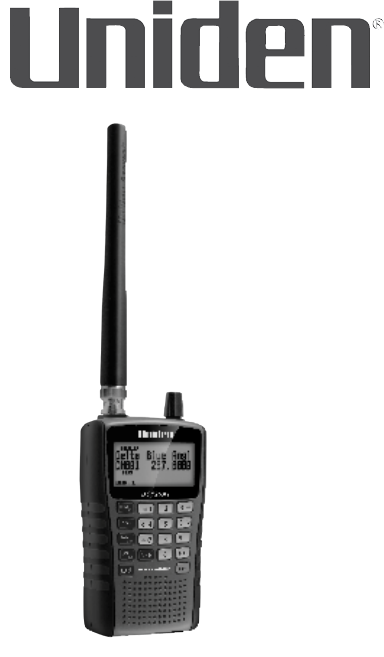
BC125AT Owners
Manual
C 2011 Uniden America Corporation
Printed in Vietnam
Fort Worth, Texas U01UB370ZZZ(0)
PRECAUTIONS
Before you use this scanner, please read and observe the
following.
EARPHONE WARNING!
Be sure to use only a monaural earphone with this scanner. You
can also use an optional mono headset. Use of an incorrect
earphone or mono headset might be potentially hazardous to
your hearing. The output of the phone jack is monaural, but you
will hear it in both headphones of a stereo headset.
Set the volume to a comfortable audio level coming from the
speaker before plugging in the monaural earphone or headset.
Otherwise, you might experience some discomfort or possible
hearing damage if the volume suddenly becomes too loud
because of the volume control or squelch control setting. This
might be particularly true of the type of earphone that is placed
in the ear canal.
WARNING!
Uniden does not represent this unit to be waterproof. To reduce
the risk of re or electrical shock, do not expose this unit to rain
or moisture.
Uniden® is a registered trademark of Uniden America
Corporation.
Close Call™ is a trademark of Uniden America Corporation.
CONTENTS
THE FCC WANTS YOU TO KNOW . . . . . . . . . . . . . . . . . . . . . . . . . 7
SCANNING LEGALLY ............................................... 7
INTRODUCTION .......................................10
FEATURE HIGHLIGHTS ............................................ 10
FREQUENCY RANGE .............................................. 14
INCLUDED WITH YOUR SCANNER .................................. 15
OPTIONAL ACCESSORIES .......................................... 16
SCANNING BASICS ....................................17
WHAT IS SCANNING? .............................................. 17
WHAT IS SEARCHING? ............................................. 17
UNDERSTANDING SCANNING ..................................... 18
What is CTCSS/DCS? ..............................................18
Conventional Scanning ...........................................19
Simplex Operation ...............................................20
Repeater Operation ..............................................20
UNDERSTANDING BANKS ......................................... 20
Channel Storage Banks ...........................................20
Service Search Banks .............................................21
Custom Search Banks ............................................21
WHERE TO LEARN MORE .......................................... 21
SETTING UP YOUR SCANNER. . . . . . . . . . . . . . . . . . . . . . . . . . . 23
CONNECTING THE ANTENNA ...................................... 23
Connecting an Optional Antenna . . . . . . . . . . . . . . . . . . . . . . . . . . . . . . . . . 24
CONNECTING AN EARPHONE/HEADPHONE . . . . . . . . . . . . . . . . . . . . . . . . 24
CONNECTING AN EXTENSION SPEAKER . . . . . . . . . . . . . . . . . . . . . . . . . . . . 24
ADJUSTING THE BELT CLIP ........................................ 24
CONNECTING TO A COMPUTER .................................... 25
POWERING THE SCANNER ......................................... 25
Installing Non-Rechargeable Batteries . . . . . . . . . . . . . . . . . . . . . . . . . . . . 26
Installing Rechargeable Ni-MH Batteries . . . . . . . . . . . . . . . . . . . . . . . . . . 26
Charging the Ni-MH Batteries .....................................27
ABOUT YOUR SCANNER ...............................28
GETTING TO KNOW THE SCANNER ................................. 29
TURNING ON THE SCANNER ....................................... 32
SETTING UP YOUR SCANNER ...................................... 32
Using the SCROLL CONTROL Knob ...........................33
Adjusting the Volume ............................................33
Adjusting the Squelch ............................................34
Setting the Backlight .............................................34
Adjusting the Contrast ...........................................35
Setting the Charging Timer .......................................36
Using the Keypad Lock ...........................................37
Setting the Beep Tone ............................................37
Resetting the Scanner ............................................37
CONTROLS, KEYS, AND FUNCTIONS . . . . . . . . . . . . . . . . . . . . . . . . . . . . . . . 37
A LOOK AT THE DISPLAY. . . . . . . . . . . . . . . . . . . . . . . . . . . . . . . . . . . . . . . . . . . 41
PROGRAMMING CHANNELS ...........................42
PROGRAMMING CHANNEL TEXT TAGS . . . . . . . . . . . . . . . . . . . . . . . . . . . . . 44
SETTING CTCSS/DCS FOR A CHANNEL . . . . . . . . . . . . . . . . . . . . . . . . . . . . . 44
SETTING THE MODULATION FOR A CHANNEL . . . . . . . . . . . . . . . . . . . . . . 46
SETTING THE PRIORITY CHANNEL . . . . . . . . . . . . . . . . . . . . . . . . . . . . . . . . . 46
SETTING CHANNEL DELAY ........................................ 47
DELETING CHANNELS ............................................. 48
CLEARING A BANK ................................................ 48
SCANNING STORED CHANNELS. . . . . . . . . . . . . . . . . . . . . . . . . . . . . . . . . . . . 49
Priority Scan Modes ..............................................51
MANUALLY SELECTING A CHANNEL . . . . . . . . . . . . . . . . . . . . . . . . . . . . . . . 51
Locking Out Channels ............................................52
Unlocking Channels ..............................................53
Unlock all Channels in Banks Currently Enabled for Scan . . . . . . . . . . . 53
SERVICE SEARCH MODE ........................................... 53
Service Search Receive/Hold Modes . . . . . . . . . . . . . . . . . . . . . . . . . . . . . . . 54
Custom Search Mode .............................................55
Custom Search Receive/Hold Modes . . . . . . . . . . . . . . . . . . . . . . . . . . . . . . . 56
Quick Search Mode ...............................................57
Quick Search Receive/Hold Modes . . . . . . . . . . . . . . . . . . . . . . . . . . . . . . . . 58
Search Options ..................................................58
Unlocking Search Frequencies ....................................61
CLOSE CALL ...................................................... 62
Using the Close Call Feature ......................................62
Selecting Close Call Modes ........................................63
Setting Close Call Options ........................................66
WEATHER OPERATION .................................69
SEARCHING FOR A WEATHER BROADCAST . . . . . . . . . . . . . . . . . . . . . . . . . 69
WEATHER ALERT STANDBY ........................................ 70
WEATHER ALERT PRIORITY ........................................ 70
REFERENCES ..........................................71
CTCSS FREQUENCIES .............................................. 71
DSC CODES ....................................................... 72

7
THE FCC WANTS YOU TO KNOW
This scanner has been tested and found to comply with
the limits for a scanning receiver, pursuant to Part 15 of the
FCC Rules. These limits are designed to provide reasonable
protection against harmful interference in a residential
installation. This scanner generates, uses, and can radiate radio
frequency energy and, if not installed and used in accordance
with the instructions, may cause harmful interference to radio
communications.
However, there is no guarantee that interference will not
occur in a particular installation. If this scanner does cause
harmful interference to radio or television reception, which
can be determined by turning the scanner on and o, you are
encouraged to try to correct the interference by one or more of
the following measures:
• Reorient or relocate the receiving antenna
• Increase the separation between the scanner and the
receiver
This device complies with Part 15 of the FCC Rules. Operation is
subject to the following two conditions:
1. This device may not cause harmful interference, and
2. this device must accept any interference received, including
interference that may cause undesired operation.
SCANNING LEGALLY
Your scanner covers frequencies used by many dierent
groups, including police and re departments, ambulance
services, government agencies, private companies, amateur
8
radio services, military operations, pager services, and wire-line
(telephone and telegraph) service providers. It is legal to listen to
almost every transmission your scanner can receive.
However, there are some transmissions that you should never
intentionally listen to. These include:
• Telephone conversations (cellular, cordless, or other private
means of telephone signal transmission)
• Pager transmissions
• Any scrambled or encrypted transmissions
According to the Electronic Communications Privacy Act
(ECPA), you are subject to nes and possible imprisonment
for intentionally listening to, using, or divulging the contents
of such a conversation unless you have the consent of a party
to the conversation (unless such activity is otherwise illegal).
This scanner has been designed to prevent the reception of
cellular telephone transmissions and the decoding of scrambled
transmissions. This is done to comply with the legal requirement
that scanners be manufactured so they are not easy to modify
to pick up these transmissions. Do not open your scanner’s
case to make any modications that could allow it to pick up
transmissions that are illegal to monitor. Modifying or tampering
with your scanner’s internal components or using it in a way
other than as described in this manual could invalidate your
warranty and void your FCC authorization to operate it.
In some areas, mobile use of this scanner is unlawful or requires
a permit. Check the laws in your area. It is also illegal in many
areas (and a bad idea everywhere) to interfere with the duties
of public safety ocials by traveling to the scene of an incident
without authorization.

9
Changes or modications to this product not expressly approved
by Uniden, or operation of this product in any way other than as
detailed by this Operating Guide, could void your authority to
operate this product.
INTRODUCTION
Thank you for purchasing a Uniden BC125AT Handheld Scanner.
The scanner is versatile, compact, and easy to use. In addition
to its standard scanning features, your scanner also includes
Close Call™ RF capture technology designed to help you detect
and identify strong local radio signals in your area. You can
program up to 500 frequencies into the scanner's memory either
manually or using optional computer software. The scanner
lets you scan transmissions and is preprogrammed with service
banks for your convenience. You can quickly search those
frequencies most commonly used by police and other agencies,
without tedious and complicated programming. The scanner
gives you direct access to over 40,000 exciting frequencies. Use
your scanner to monitor:
• Police and re departments (including rescue and
paramedics)
• NOAA weather transmissions
• Utilities
• Marine and amateur (ham radio) bands
• Air band
• Itinerant Business/Industrial, GMRS, FRS bands
• CB bands
• Military and Federal Government bands
10
FEATURE HIGHLIGHTS
10 Channel Storage Banks - You can store up to 50 frequencies
into each bank for a total of 500 frequencies so you can more
easily identify calls.
Close Call™ RF Capture Technology - you can set the scanner
so it detects and provides information about nearby radio
transmissions
Close Call Do-Not-Disturb - checks for Close Call activity
in between channel reception so active channels are not
interrupted.
Close Call Temporary Store - temporarily stores and scans the
last 10 Close Call hits in the Close Call Hits system.
PC Programming - you can download information into the
scanner and control the scanner via your personal computer.
CTCSS and DCS Squelch Modes - rapid search for CTCSS/DCS
tones/codes used during a transmission. You can identify up to
50 CTCSS tones and 104 DCS codes.
Direct Access - lets you directly access any channel.
Lock-Out Function - lets you set your scanner to skip over
specied channels or frequencies when scanning or searching.
Temporary Lockout - makes it easy to temporarily lock out
any channel or frequency. The lockout is cleared when you
turn power o, then back on so you don’t have to remember to
unlock the channels later.
Triple-Conversion Circuitry - virtually eliminates any
interference from IF (intermediate frequency) images, so you
hear only the selected frequency.
11
Text Tagging - you can name each channel, using up to 16
characters per name.
Service Banks - frequencies are preset in 10 separate Police,
Fire/Emergency, Ham, Marine, Railroad, Civil Air, Military Air, CB
Radio, FRS/GMRS/MURS, and Racing banks to make it easy to
locate specic types of calls and search any or all of these banks.
Priority Scan with Do Not Disturb - lets you program one
channel in each bank (10 in all) and then have the scanner check
each channel every 2 seconds while it scans the banks so you
don’t miss transmissions on those channels. Do-Not Disturb
keeps the scanner from interrupting transmissions during
receiving.
Priority Plus Scan - you can set the scanner so it scans only the
priority channels.
Scan/Search Delay/Resume - controls whether the scanner
pauses at the end of the transmission to wait for a reply. You can
set the Delay time for each Channel, Close Call Search, Custom
Search, and Service search. You can also set a negative delay
where the scanner stops on transmissions for a set time then
automatically resumes.
Custom Search - lets you program up to 10 Custom Search
Ranges and search any or all of these ranges.
Quick Search - allows you to enter a frequency and start
searching up or down from that frequency.
Turbo Search - increases the search speed from 100 to 300 steps
per second automatically for bands with 5 kHz steps.
Search Lockouts - you can lock up to 200 search frequencies:
100 temporary frequencies and 100 permanent frequencies
12
in Custom Search, Service Search, Close Call Search, or Quick
Search Modes.
Weather Alert Priority - the scanner scans active WX channels
every 5 seconds to check for the presence of a 1050 Hz Weather
Alert Tone.
Weather Alert Standby - the scanner allows you to monitor for
weather alerts broadcast on NOAA channels.
Display Backlight - You can turn on/o the LCD backlight, set it
operate on squelch only, keypress only, or both.
Signal Strength Meter - shows the signal strength for more
powerful transmissions.
Flexible Antenna with BNC Connector - provides adequate
reception in strong signal areas and is designed to help prevent
antenna breakage. You can also connect an external antenna for
better reception.
Memory Backup - keeps the frequencies stored in memory for
an extended time if the scanner loses power.
Two Power Options - let you power the scanner using the
included two AA rechargeable or alkaline batteries or the
supplied USB cable.
Built-In Charger - allows you to charge Ni-MH batteries in the
scanner using a USB port on any computer and the supplied
USB cable.
Key Conrmation Tones - You can turn on/o a tone that
sounds when you perform an operation correctly or if you make
an error.
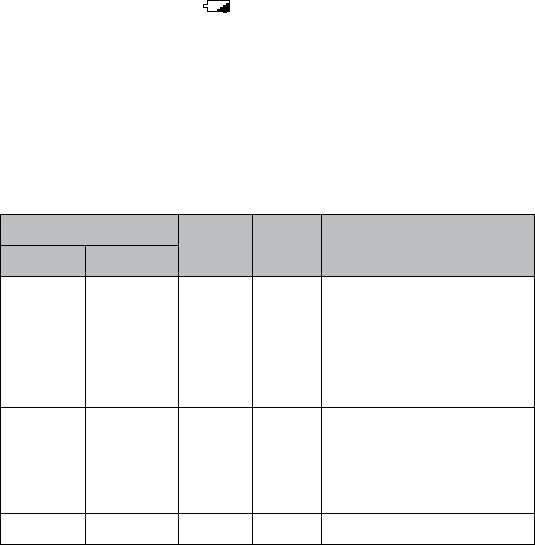
13
Key Lock - lets you lock the scanner's keys to help prevent
accidental changes to the scanner's programming.
Battery Save - works when there is no transmission for 1 minute
in Scan Hold mode and any Search Hold mode (without
Priority Scan). This feature turns o RF power for 1 second and
turns on it for 300ms to extend the battery life.
Battery Low Alert - the icon will blink in the display and a
tone warns you every 15 seconds when the battery power gets
low.
FREQUENCY RANGE
This table lists the frequency ranges, frequency steps, default
modulation, and type of transmissions you can hear for each
range.
FREQUENCY MODE STEP
(KHz) Band
LOWER UPPER
25.000 27.995 AM 5.0
•Petroleum Products &
Broadcast Pickup
•CB Class D Channel
•Business & Forest
Products
28.000 54.000 NFM 5.0
•Meter Amateur Band
•VHF Low Band
•6 Meter Amateur
Band
108.000 136.9916 AM 8.33 Aircraft Band
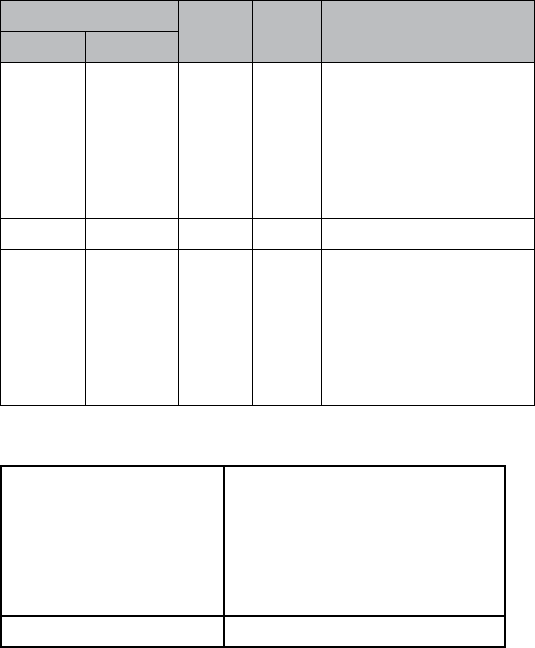
14
FREQUENCY MODE STEP
(KHz) Band
LOWER UPPER
137.000 174.000 NFM 5.0
•Military Land Mobile
•2 Meter Amateur
Band
•Military Land Mobile
•VHF High Band
•Federal Government
225.000 380.000 AM 12.5 •Military Air Band
400.000 512.000 NFM 6.25
•Miscellaneous
•Federal Government
Land Mobile
•70 cm Amateur Band
•UHF Standard Band
•UHF TV
INCLUDED WITH YOUR SCANNER
BC125AT Antenna
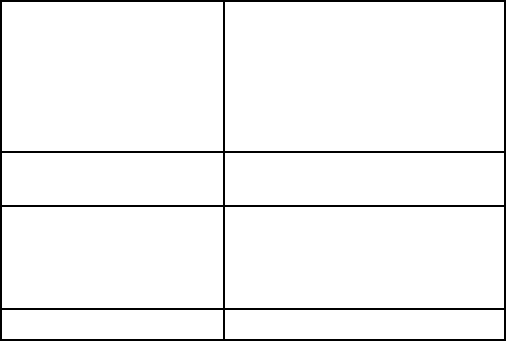
15
Ni-MH Rechargeable
Batteries
USB Cable
Belt Clip (Attached) Headset
If any of these items are missing or damaged, immediately
contact your place of purchase or Uniden Customer Service
at: (800) 297-1023, 8:00 AM to 5:00 PM, CST, Monday through
Friday.
OPTIONAL ACCESSORIES
Contact your local Uniden Dealer or call the Uniden Parts
Center at: (800)554-3988, 8:00AM to 5:00PM EST, Monday
through Friday, for information about ordering these optional
accessories.
[optional accessories graphic]
Note: USB cables are available from the Uniden On-Line store.
Visit http://www.uniden.com.

16
SCANNING BASICS
This section provides you with background on how scanning
works. You don’t really need to know all of this to use your
scanner, but some background knowledge will help you get the
most from your BC125AT.
WHAT IS SCANNING?
Unlike standard AM or FM radio stations, most two-way
communications do not transmit continuously. Your BC125AT
scans programmed channels until it nds an active frequency,
then stops on that frequency and remains on that channel as
long as the transmission continues. When the transmission ends,
the scanning cycle resumes until the scanner receives another
transmission.
WHAT IS SEARCHING?
The BC125AT can search for active frequencies. This is dierent
from scanning because you are searching for frequencies that
have not been programmed into the scanner. When you select
frequency bands to search, the scanner searches for any active
frequency within the lower and upper limits you specify. When
the scanner nds an active frequency, it stops on that frequency
as long as the transmission lasts. If you think the frequency is
interesting, you can store it into one of the banks. If not, you can
continue to search.
17
UNDERSTANDING SCANNING
What is CTCSS/DCS?
Your scanner can monitor systems using a Continuous Tone
Coded Squelch System (CTCSS) and Digital Coded Squelch (DCS)
system, which allows the squelch to open only when the tone
you have programmed with a specic frequency is received
along with a transmission.
CTCSS and DCS are sub-audible tone signaling systems
sometimes referred to as PL or DPL (Motorola’s trademarked
terms for Private Line and Digital Private Line respectively).
CTCSS and DCS are used only for FM signals and are usually
associated with both amateur and commercial two-way
frequencies. These systems make use of a special sub-audible
tone that accompanies a transmitted signal.
CTCSS and DCS are used for many purposes. In many cases,
CTCSS and DCS are used to restrict access to a commercial
repeater, so that only those units which transmit the correct
tone along with their signal can “talk” to the repeater.
CTCSS and DCS are also used in areas that receive interference
where there are several stations with output frequencies close
to each other. When this occurs, you might hear multiple
communications on the same frequency. The stations
might even interfere with each other to the point where it is
impossible to clearly receive any of the stations. Your scanner
can code each received frequency with a specic sub-audible
CTCSS or DCS frequency or code. Then, when you receive
multiple signals, you only hear the transmission with the CTCSS
or DCS tone you programmed. If you do not receive the correct
18
tone with a signal, the scanner’s squelch remains closed and you
hear nothing.
The tables showing the available CTCSS frequencies and DCS
codes are found in the Reference Section of this manual.
Conventional Scanning
Conventional scanning is a relatively simple concept. Each
group of users in a conventional system is assigned a single
frequency (for simplex systems) or two frequencies (for repeater
systems). Any time one of them transmits, their transmission
always goes out on the same frequency. Up until the late 1980’s
this was the primary way that radio systems operated.
Even today, there are many 2-way radio users who operate using
a conventional system:
• Aircraft
• Amateur radio
• FRS/GMRS users
• Broadcast AM/FM/TV stations
• Many business radio users
When you want to store a conventional system, all you need
to know is the frequencies they operate on. When you are
scanning a conventional system, the scanner stops very briey
on each channel to see if there is activity. If there isn’t, the
scanner quickly moves to the next channel. If there is, then the
scanner pauses on the transmission until it is over.
19
Simplex Operation
Simplex systems use a single frequency for both transmit and
receive. Most radios using this type of operation are limited to
line-of-sight operation. This type of radio is frequently used at
construction job sites, and with inexpensive consumer radios
such as GMRS/FRS radios. The range is typically 1-8 miles,
depending upon the terrain and many other factors.
Repeater Operation
Repeater systems use two frequencies: one transmits from the
radio to a central repeater; the other transmits from the repeater
to other radios in the system. With a repeater-based system, the
repeater is located on top of a tall building or on a radio tower
that provides great visibility to the area of operation.
When a user transmits (on an input frequency), the signal is
picked up by the repeater and retransmitted (on an output
frequency). The user’s radios always listen for activity on the
output frequency and transmit on the input frequency. Since
the repeater is located very high, there is a very large line of
sight. Typical repeater systems provide coverage out to about a
25-mile radius from the repeater location.
UNDERSTANDING BANKS
Channel Storage Banks
To make it easier to identify and select the channels you want to
listen to, the 500 channels are divided into 10 channel storage
banks containing 50 channels each. You could use each channel
storage bank to group frequencies by department, location,
area of interest, or any other way you prefer. You can listen to
20
any or all of the banks by using the number keys to turn them
on or o.
Service Search Banks
The scanner is preprogrammed with many of the frequencies
allocated to Police, Fire/Emergency, Ham, Marine, Railroad, Civil
Air, Military Air, CB radio, FRS/GMRS/MURS, and Racing services.
There are 10 banks allocated for these searches that can be used
just lik the chanel storage banks to search these frequencies in
Service Search mode.
Custom Search Banks
Custom Search Banks let you program and search 10 custom
search ranges. During custom search, the scanner starts
searching with the lowest frequency in the search range you
select to the highest frequency in the range. You can search any
or all of these ranges by turning each search bank on or o just
like channel storage banks in Search mode.
WHERE TO LEARN MORE
By itself, this manual really only provides part of what you need
to know to have fun scanning – how to program and use the
scanner. The following internet sites will help you make a list of
the agencies you want to listen to and look up the frequencies
and systems used by those agencies.
http://www.radioreference.com - the Internet's premier source
for user-supported radio system information.
http://www.bearcat1.com - frequency information from
National Communications.
21
http://sjallfoss.fcc.gov/General_Menu_Reports/index.cfm
- conventional frequency information on le with the US
Government.
http://www.scannermaster.com - frequency resources and
home of Police Call.
You can also call them at 1 800 SCANNER (hours are from 9:00
a.m. to 5:30 p.m. Eastern Time Monday through Friday).
These web sites are not aliated with Uniden Corporation.
For more information about Uniden and our other products,
visit http://www.uniden.com.

22
SETTING UP YOUR SCANNER
These guidelines will help you install and use your new scanner.
If your scanner receives interference or electrical noise, move
the scanner or its antenna away from the source. You might also
try changing the height or angle of the telescoping antenna.
To improve the scanner’s reception, use an optional external
antenna designed for multiband coverage. (You can purchase
this type of antenna at a local electronics store). If the optional
antenna has no cable, use 50-70 ohm coaxial cable for lead-in.
An adapter plug might be necessary for the optional antennas.
Use an optional mono earphone or mono headset with proper
impedance for private listening. Read the precautions on the
inside front cover of this Owners Manual.
Do not use the scanner in high-moisture environments such as
the kitchen or bathroom.
Avoid placing the scanner in direct sunlight or near heating
elements or vents.
CONNECTING THE ANTENNA
1. Align the slots around the antenna's connector with the
tabs on the scanner's BNC connector.
2. Slide the antenna's connector down over the scanner's
connector.
3. Rotate the antenna connector's outer ring clockwise until it
locks into place.
23
Connecting an Optional Antenna
The scanner's BNC connector makes it easy to connect a variety
of optional antennas, including an external mobile antenna or
outdoor base station antenna.
Note: Always use 50-ohm, RG-58, or RG-8, coaxial cable to connect
an outdoor antenna. If the antenna is over 50 feet from the scanner,
use RG-8 low-loss dielectric coaxial cable. If it is less than 50 feet,
use RG-58. You can get a BNC adapter at local electronics stores.
CONNECTING AN EARPHONE/HEADPHONE
For private listening, you can plug a 1/8-inch (3.5 mm) mini-
plug earphone or mono headphones (not supplied) into the
headphone jack on top of your scanner. This automatically
disconnects the internal speaker.
CONNECTING AN EXTENSION SPEAKER
In a noisy area, an optional extension speaker, positioned in the
right place, might provide more comfortable listening. Plug the
speaker cable's 1/8-inch (3.5-mm) mini-plug into your scanner's
jack.
WARNING! If you connect an external speaker to the
scanner's headphone jack, never connect the audio
output line to a power supply and ground. This might
damage the scanner.
ADJUSTING THE BELT CLIP
The factory-attached belt clip makes it easier to carry the
scanner. Use a Phillips screwdriver to adjust (loosen) the
mounting screws or remove the belt clip completely.

24
POWERING THE SCANNER
You can power the scanner using alkeline (ALK) non-
rechargeable batteries (not supplied) or the included Nickel
Metal-Hydride (Ni-MH) rechargeable batteries. (Uniden provides
a USB cable to charge the Ni-MH batteries on initial installation
and to recharge them through your computer.)
Inside the battery compartment is a switch to set the unit to
either ALK or Ni-MH.
WARNING! Non-rechargeable batteries can get hot or burst
if you try to recharge them.
CAUTIONS:
• When ashes in the display and the scanner beeps
every 15 seconds, replace both batteries.
• Use only fresh batteries of the required size and
recommended type.
• Always remove old or weak batteries. Batteries can leak
chemicals that destroy electronic circuits.
• Do not mix old and new batteries, dierent types of batteries
(standard, alkaline, or rechargeable), or rechargeable
batteries of dierent capacities.
Installing Non-Rechargeable Batteries
1. Make sure the power is turned o.
2. Slide the battery compartment cover o.
3. Use a pointed object such as a ballpoint pen to set the
battery selection switch inside the compartment to ALK.
25
4. Insert the batteries as indicated by the polarity symbols (+
and -) marked inside the battery compartment.
5. Replace the battery compartment cover.
Installing Rechargeable Ni-MH Batteries
You can also use two Ni-MH rechargeable batteries to power
your scanner. The Ni-MH batteries included with your unit are
not fully charged; you must charge them completely after you
install them into your scanner. See Using the USB Cable, page
___, for details.
1. Make sure the power is turned o.
2. Slide the battery compartment cover o.
3. Use a pointed object such as a ballpoint pen to set the
battery selection switch inside the compartment to NIMH
for Nickel Metal-Hydride batteries.
4. Install two batteries in the compartment as indicated by
the polarity symbols (+ and -) marked inside and replace
the cover.
Notes:
• To prevent damage to Ni-MH batteries, never charge them
in an area where the temperature is above 113°F (45°C) or
below 40°F (4°C).
• For longer operation, you can get higher capacity Ni-MH
batteries at your local electronics store. This type of battery
takes longer to recharge.
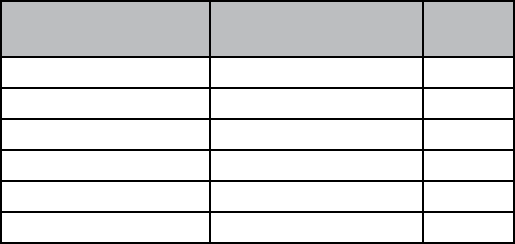
26
Charging the Ni-MH Batteries
The scanner has a built-in circuit that charges the included Ni-
MH batteries when a USB cable connects it to a computer. Verify
that the battery selection swith is set to NIMH and that only
Ni-MH rechargeable batteries are inserted in the scanner before
connecting it to your computer.
CAUTION: Never attempt to charge non-rechargeable
batteries or install non-rechargeable batteries when
the battery selection switch is set to Ni-MH.
1. Connect the included USB cable to the scanner’s USB port.
2. Connect the other end of the USB cable to the computer's
USB port.
3. The scanner displays Charging while it charges the
batteries and Charge Complete when the Ni-MH batteries
are completely charged.
Dierent status messages may display depending on the
battery type and scanner status:
USB Message Battery Type Scanner
Cond.
CHARGING Ni-MH Off
No batteries None Off
Charge Off ALK, Rechargeable Off
Battery Error Non-Rechargeable Off
Illegal Voltage Unchargeable Off
Battery icon blinks Ni-MH, unknown cond. On
See also Setting the Charging Timer on page ___.

27
If the batteries are good, the scanner charges the batteries.
and it operates ordinarily. If the scanner cannot immediately
determine if the batteries to be good, it checks them and
displays the battery icon. If the scanner judges the batteries
as a good, the scanner starts charging and the battery icon
disappears. If it cannot regard the batteries as good in 60
seconds, the scanner stops checking and the battery icon blinks.
ABOUT YOUR SCANNER
We use a few simple terms in this manual to explain the features
of the scanner. Familiarize yourself with these terms and the
scanner's features, and you can put the scanner to work for
you right away. Simply determine the type of communications
you want to receive, then set the scanner to search those
communications.
A frequency, expressed in kHz or MHz, is the tuning location of
a station. To nd active frequencies, you use the search function
or refer to a frequency reference.
Besides searching within a selected frequency range, you can
also search your scanner's service banks. Service banks are
preset groups of frequencies categorized by the type of services
that use those frequencies. For example, many amateur radio
frequencies are located in the HAM service bank.
When you search and nd a desired frequency, you can store
it into a programmable memory location called a channel.
Channels are grouped into channel storage banks. The scanner
has 10 channel storage banks and each bank has 50 channels.
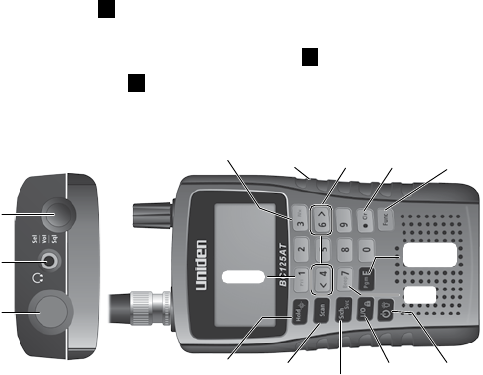
28
You can scan the channel storage banks to see if there is activity
on the frequencies stored there.
GETTING TO KNOW THE SCANNER
If your scanner's keys seem confusing at rst, the following
information should help you understand each key's function.
Your scanner's keys have various functions labeled on the key
tops and below the keys. The keys operate in Normal mode and
Function mode. Pressing Func puts the scanner into Function
mode for 3 seconds and then returns to Normal mode. The
scanner displays F . During that 3 seconds you can press other
keys and operate that function. Pressing Func again before 3
seconds returns to Normal mode and the F icon disappears.
In Normal mode the F icon is not displayed.
HEADSET
JACK
ANTENNA
HOLD/
CLOSE CALL
SCAN
SEARCH/
SERVICE SEARCH
LOCK OUT/
KEY LOCK
POWER/
BACKLIGHT
PROGRAM/
ENTER
FUNCTION
DECIMAL/
CLEAR
WEATHER
PRIORITY
BEEP
CURSER
LEFT/RIGHT
SCROLL
CONTROL
USB
PORT
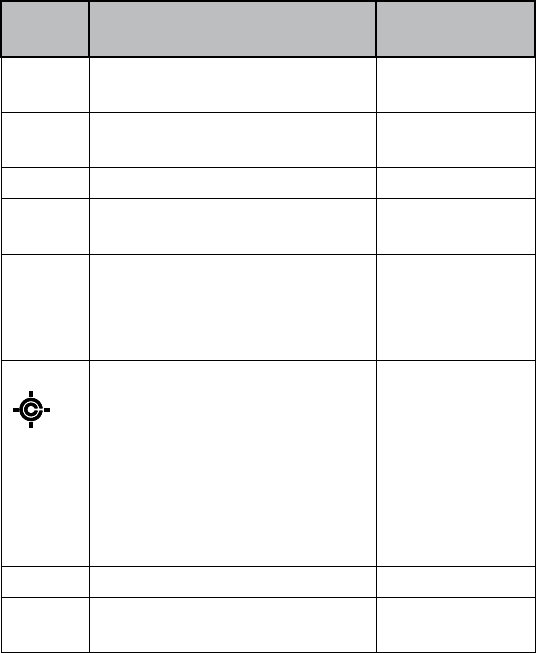
29
Key/
Icon
Press to... Press Func and
this key to...
1/PRI Enter 1. Enter the Priority
menu.
3/WX Enter 3. Enter the
Weather menu.
6/> Enter 6. Scroll right.
. Clr •Enter a decimal point.
•Input a space in a text string.
Clear a digit.
func •Enter Function mode for 3
seconds.
•Return to Normal mode from
Function mode.
NA
Hold/ •Hold on a current channel.
•Release hold and resume
scanning.
•Monitor an unprogrammed
frequency after you have
entered it.
•Access a channel directly after
you have entered it.
Open the Close
Call menu.
Scan Enter or resume Scan mode. NA
Srch/
Svc
Resume searching. Start Service
Search.
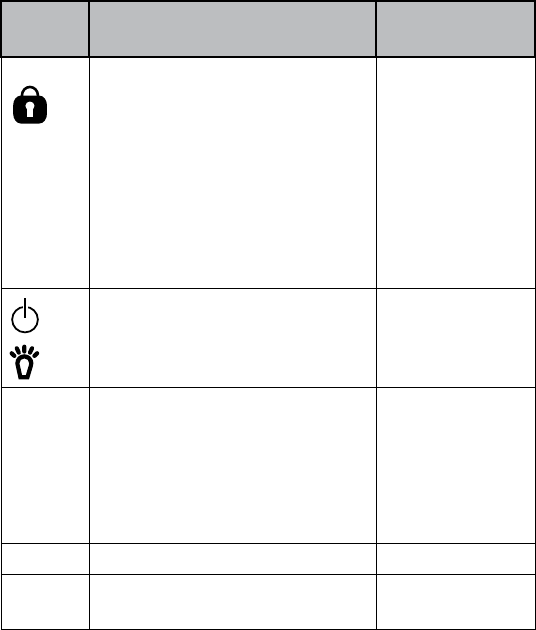
30
Key/
Icon
Press to... Press Func and
this key to...
L/O/ •Temporarily lock out a channel
or search frequency (press
once).
•Permenantly lock out a
channel or search frequency
(press twice).
•Unlock alllocked out settings
of the current channel bank
(press and hold).
Lock or unlock
the keypad.
/
•Turn scanner on and o (press
and hold).
•Turn backlight on and o.
Enter Backlight
Options menu.
Pgm/E •Select input data or a menu
item.
•Access a channel through its
channel number.
•Enter Channel
Programming
menu.
•Quickly save
frequencies in
various modes.
4/< Enter 4. Scroll left.
7/Beep Enter 7. Enter Keybeep
menu.
Note: Turn SCROLL CONTROL to scroll up and down through
menu selections.
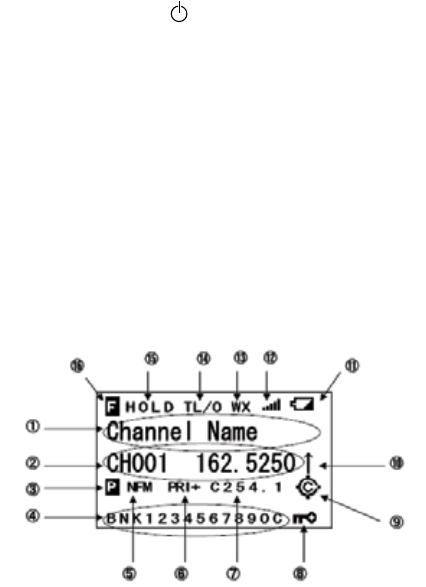
31
TURNING ON THE SCANNER
Note: Make sure the scanner's antenna is connected before you
turn it on.
1. Press and hold for 1 second to turn on the scanner. The
opening screen displays, followed by the copyright notice.
2. If the scanner is new or has been reset, the default mode is
Scan Hold with all banks enabled and Close Call Do-
Not-Disturb active. Otherwise, the scanner displays the last
mode the scanner was in before it was powered down.
A LOOK AT THE DISPLAY
The display has indicators that show the scanner's current
operating status. The display information helps you understand
how your scanner operates.
Note: Not all of these icons may appear at the same time.
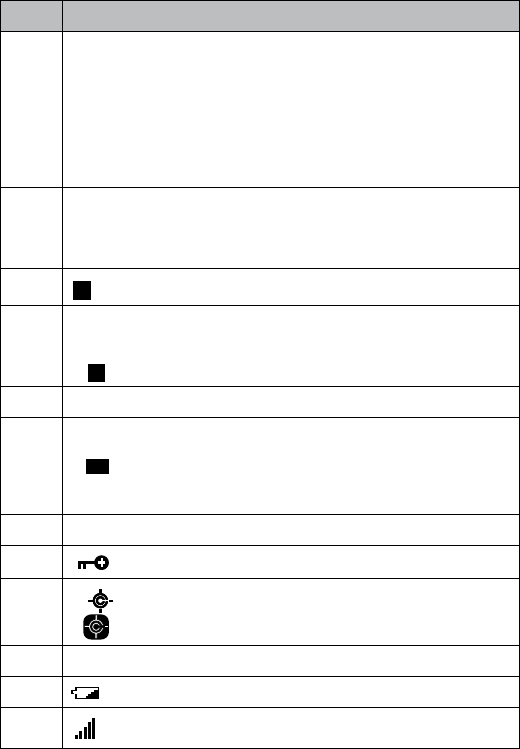
32
Item Meaning
1•Channel Name in Receive/Scan Hold mode.
•Custom/Service Search Bank Name.
•Quick Search in Quick Search mode.
•Close Call Hits in Receive/Scan Hold mode.
•Close Call in Close Call Only mode.
•WX Scan in Weather Scan mode.
2•“Scanning," “Searching," or “CC Search” scroll.
•Channel Number and Frequency.
•Searching Frequency.
3P identies a Priority channel.
4•BNK/SVC/LMT/BND shows banks/bands enabled for
scan/search/Close Call Only mode.
• C is for the Close Call Hits bank.
5 AM/FM/NFM shows channel/frequency modulation.
6•PRI indicates Priority Scan.
• PRI indicates Priority Do-Not-Disturb.
•PRI+ indicates Priority Plus Scan.
7 Shows any CTCSS/DCS tone/code received.
8 indicates the key lock is enabled.
9• indicates Close Call Priority.
• indicates Close Call Do-not-Disturb.
10 ↑or ↓ indicates the scan/search direction.
11 indicates the batteries are low.
12 indicates the signal strength.
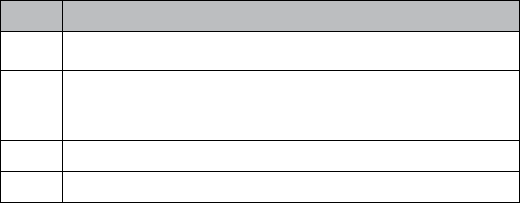
33
Item Meaning
13 WX indicates Weather Priority is on.
14 •TL/O indicates temporary lock out.
•L/O indicates permanent lock out.
15 • indicates mode type (Function or Normal).
16 Indicates Function mode.
SETTING UP YOUR SCANNER
When you turn on your scanner for the rst time, you can set
your screen display preferences as well as other elements such
as squelch levels, volumes, brightness, etc.
Using the SCROLL CONTROL Knob
Turn the SCROLL CONTROL knob on top of the BC125AT to:
• Select channels
• Adjust volume
• Adjust squelch
• Set display settings
• Selects characters for text tagging
• Scroll up or down through menu options
• Change channels/frequencies in Hold mode
• Resume scanning
Press the SCROLL CONTROL knob to select a setting.
Note: Pressing Scroll Control is the same as pressing Pgm/E on
the keypad in Menu mode.

34
Adjusting the Volume
1. Press SCROLL CONTROL; The volume level indicator and
battery voltage display.
2. Turn SCROLL CONTROL to adjust the volume level from 0
to 15.
3. Push SCROLL CONTROL to set the volume.
4. To exit Volume Level mode, push SCROLL CONTROL
again or wait 10 seconds to return to the previous mode.
Adjusting the Squelch
To adjust the squelch level, press FUNC, then push SCROLL
CONTROL. When the squelch level indicator and battery voltage
appear, turn SCROLL CONTROL to change the squelch level
from 0 to 15.
1. Press Func, then push SCROLL CONTROL. The squelch
level indicator and battery voltage appears.
2. Turn SCROLL CONTROL until the audio mutes. If the
scanner picks up unwanted partial signals or very weak
transmissions, increase the Squelch setting to decrease the
scanner's sensitivity. To listen to a weak or distant station,
decrease the Squelch setting.
3. Press SCROLL CONTROL to set the desired level and return
to the previous mode.
4. To exit Squelch mode without resetting squelch, wait 10
seconds to return to the previous mode.
Setting the Backlight
Press to turn on the backlight on and o.
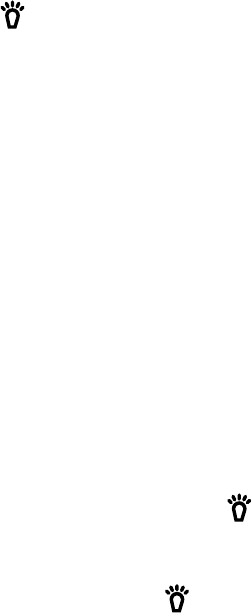
35
1. Press Func and to view the Display/Charge menu.
2. From this menu, scroll to Set Backlight from the
submenus. Press SCROLL CONTROL.
3. Scroll to select one of the following settings:
• Always O - Backlight is always o.
• Always On – Backlight is always on.
• On with Squelch - Backlight is on while squelch is open
and until delay expires.
• On with Keypress - Backlight is on for 10 seconds after
any key is pressed.
• Keypress+Squelch – Both above-mentioned "Squelch"
and "Keypress."
• Back - Return to previous menu.
4. Press Pgm/E (pr press SCROLL CONTROL) to save and
return to the previous menu. (Default = Always O )
5. Press . Clr to exit.
Notes: If the backlight is set to Always On when is pressed,
the backlight is turned o and the backlight setting is then set to
Always Off.
If the backlight is set to Always Off when is pressed, the
backlight is turned on and the backlight setting is then set to
Always On.

36
Adjusting the Contrast
This submenu of the Display/Charge menu controls the
display’s contrast (how light or dark it appears) for dierent
viewing conditions. There are 15 contrast settings. You see the
contrast change as you scroll through the settings.
1. To adjust the contrast, press Func then ; the Display/
Charge menu displays
2. Scroll to Set Contrast and press Pgm/E.
3. Scroll to see the contrast settings.
4. When you have selected a setting, press Pgm/E to set it and
return to the previous menu.
5. Press . Clr to exit.
Setting the Charging Timer
The Charging Timer menu is also a submenu of the Display/
Charge menu. It sets how long the scanner will charge the
batteries when you plug the supplied USB cable into a USB port
and connect it to your scanner.
WARNING: The Charging Timer will reset to the set charging
time every time you plug the USB cable into the
scanner or charge the batteries while the USB cable is
connected.
1. To set the Charging Timer press Func then to view the
Display/Charge menu.
2. Scroll to Set ChargeTime and press Pgm/E.
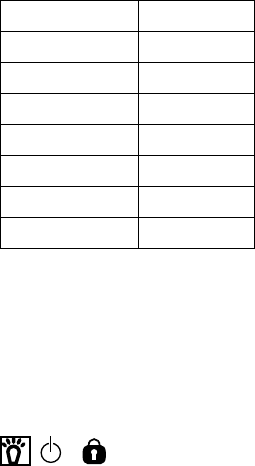
37
3. Scroll to 1-16 (hours) (default = 14 hours) and press Pgm/E
to save and return to the previous menu.
Suggested maximum charging time for Ni-MH batteries:
1500mAh 9 hours
1800mAh 11 hours
2000mAh 12 hours
2100mAh 13 hours
2200mAh 13 hours
2300mAh 14 hours
2500mAh 15 hours
2700mAh 16 hours
Note: The batteries will take longer to charge when the scanner is
in use.
4. Press . Clr to exit.
Using the Keypad Lock
Use the scanner's keypad lock to protect it from accidental
program changes. When the keypad is locked, only Func, Hold,
, , and SCROLL CONTROL (volume only) operate.
Press Func then L/O to toggle the keypad lock on and o. The
scanner displays Keypad Lock On or Keypad Lock Off.
Setting the Beep Tone
Press Func then Beep/7 (Default = ON) to toggle the keypress
conrmation tone on or o.

38
Resetting the Scanner
WARNING: Resetting the scanner clears all data and settings
you have entered. You cannot restore user programmed
data that has been deleted. You can, at a last step,
restore only the original factory data.
1. Press and hold the 2, 9, and Hold keys and turn on the
scanner.
2. The scanner clears all data and returns to the initial setting.
All Memory Cleared displays.
CONTROLS, KEYS, AND FUNCTIONS
Now that you have congured your scanner, you are ready to
start using your scanner’s preprogrammed service banks, the
custom search banks, the Close Call feature, or the Weather
Scan/Alert feature. You can also program your channel
memories or re-program your 10 custom search bank memories.
PROGRAMMING CHANNELS
Before the scanner can begin scanning, you must program a
frequency into at least one channel.
1. To select a channel, press Hold then enter the channel
number.
2. Press Pgm/E to enter the Channel menu. (You can also
press Hold and scroll to the channel; press Func then
Pgm/E.)
Note: Turning SCROLL CONTROL in Function mode will allow
you to select the rst channel in each bank.
39
You can quickly store frequencies in Scan Hold mode by
entering the frequency and pressing Pgm/E.
1. Scroll to select Enter Frequency and press Pgm/E. You
will see the channel number and currently programmed
frequency. To return, press . Clr.
2. Use number keys and . Clr for a decimal to enter the
frequency. If you make a mistake, press . Clr to clear the
display. Press Pgm/E to store the frequency and return to
the Channel menu.
Notes:
• The scanner automatically rounds the entered number to the
nearest valid frequency. For example, if you enter 151.473
(MHz), your scanner accepts it as 151.475.
• If you entered an invalid frequency, Out of Band appears
and the scanner beeps three times. Press . Clr and enter a
valid frequency.
• If you enter a frequency that has already been entered
elsewhere, the scanner displays the channel number and
Frequency Exists – Conrm? appears.
• If you entered the frequency by mistake, press . Clr then
enter the correct frequency. To enter the frequency anyway,
press Pgm/E to accept.
The smallest channel is displayed when two or more duplication
channels exist.
40
PROGRAMMING CHANNEL TEXT TAGS
You can customize your channels by programming text tags
(up to 16 characters in length) for easier channel frequency
identication. The default tag is the bank number followed by
the channel number in the bank.
1. To select a channel, press Hold and then enter the channel
number.
2. Press Pgm/E to enter the Channel menu. (You can also
press Hold and scroll to the channel; press Func then
Pgm/E.)
3. Scroll to select Edit Tag and press Pgm/E.
4. Turn SCROLL CONTROL to choose the characters, pressing
> or < to move the cursor to the right or left. If you make a
mistake, press . CLR to clear the last character. Press . CLR
twice to clear all characters. To cancel and exit, press L/O.
5. Press Pgm/E to save the tag and return to the Channel
menu.
SETTING CTCSS/DCS FOR A CHANNEL
You can store a CTCSS tone or DCS code, set the scanner to
search for tones/codes, have the scanner open squelch on any
tone/code, or have the squelch only open if no CTCSS/DCS is
detected for any channel. (Default = O)
1. To select a channel, press Hold and then enter the channel
number.
41
2. Press Pgm/E to enter the Channel menu. (You can also
press HOLD and scroll to the channel; press Func then
Pgm/E.)
3. Scroll to select Set CTCSS/DCS and press Pgm/E.
4. Scroll to select one of the following options:
• Off - the scanner ignores all tones and opens squelch on
any signal
• CTCSS - the scanner prompts the user for the
appropriate setting. Squelch will open for this channel
only if the code matches.
• DCS - the scanner prompts the user for the appropriate
setting. Squelch will open for this channel only if the
code matches.
• CTCSS/DCS Search - the scanner displays any tone
being used, but opens squelch on any signal.
• No Tone - indicates that the channel squelch will only
open if no CTCSS/DCS is detected.
• Back - returns to Channel Menu.
Note: If you select Off, CTCSS/DCS Search, or No Tone, the
scanner returns to the channel menu.
If you selected CTCSS or DCS, you can then select the CTCSS
tone or DCS code.
5. Scroll to select, then press Pgm/E to save and return to the
Channel menu.
42
SETTING CHANNEL MODULATION
1. To select a channel, press Hold and then enter the channel
number.
2. Press Pgm/E to enter the Channel menu. (You can also
press Hold and scroll to the channel; press Func then
Pgm/E.)
3. Scroll to select Set Modulation and press Pgm/E.
4. Scroll to select modulation from the following options
(Default = Auto):
• Auto - the scanner selects the modulation automatically
for the frequency’s band.
• AM - the scanner uses AM modulation.
• NFM - the scanner uses Narrowband FM modulation.
• FM - the scanner uses FM modulation.
5. Press Pgm/E to save and return to the Channel menu.
SETTING THE PRIORITY CHANNEL
The Priority feature lets you scan through the channels and still
not miss important or interesting calls on specic channels. You
can set one stored channel in each bank as a priority channel.
If the Priority feature is turned on, as the scanner scans the
bank, it checks that bank's priority channel for activity every 2
seconds.
To Set a Priority Channel in a Bank
1. To select a channel, press Hold then enter the channel
number

43
2. Press Pgm/E to enter the Channel menu. (You can also
press Hold and scroll to the channel; press Func then
Pgm/E.)
3. Scroll to select Set Priority and press Pgm/E.
4. Scroll to Priority On and press Pgm/E to save and return to
the Channel Menu.
5. P displays to identify a Priority channel.
SETTING CHANNEL DELAY
This setting controls how many seconds the scanner waits after
a transmission ends before resuming scanning. If you select a
minus delay time, the scanner stops on the transmission for the
setting time, then automatically resumes scanning. (Default = 2
seconds)
1. To select a channel, press Hold then enter the channel
number.
2. Press Pgm/E to enter the Channel menu. (You can also
press Hold and scroll to the channel; press Func then
Pgm/E.)
3. Scroll to select Set Delay and press Pgm/E.
4. Scroll to select the delay time from the following options:
• -10 sec - resumes after 10 seconds.
• -5 sec - resumes after 5 seconds.
• 0 sec - resumes immediately.
• 1 sec - waits 1 second for a reply then resumes.
• 2 sec - waits 2 seconds for a reply then resumes.
44
• 3 sec - waits 3 seconds for a reply then resumes.
• 4 sec - waits 4 seconds for a reply then resumes.
• 5 sec - waits 5 seconds for a reply then resumes.
4. Press Pgm/E to save and return to the Channel menu.
DELETING CHANNELS
You can delete all programming for a channel.
1. To select a channel, press Hold then enter the channel
number.
2. Press Pgm/E to enter the Channel menu. (You can also
press Hold and scroll to the channel; press Func then
Pgm/E.)
3. Scroll to select Delete Channel and press Pgm/E.
[conrm delete channel graphic]
4. At Conrm Delete?, press Pgm/E to delete the channel or
.Clr to cancel and return to the Channel menu.
Clearing a Bank
You can delete all channels in a bank.
1. Press Hold to select any channel in the bank, then enter
that channel number.
2. Press Pgm/E to enter the Channel menu. (You can also
press Hold and scroll to the channel; press Func then
Pgm/E.)
3. Scroll to select Clear Bank and press Pgm/E.
45
4. To clear the Close Call Hits bank, turn o the scanner and
turn it back on.
5. At Conrm Clear?, press Pgm/E to clear the bank or . Clr
to cancel and return to the Channel menu.
SCANNING STORED CHANNELS
Press Scan to begin scanning channels.
The scanner scans through all unlocked channels in the enabled
banks in channel order. When the scanner nds a transmission,
it stops on it.
When the scanning of all normal banks ends, the scanner
scans a channel storage bank that is named Close Call Hits (if
enabled). This is a storage bank that automatically stores found
frequencies with any Close Call mode. You will see Close Call
Hits on the display. If the Close Call Hits bank is empty, the
scanner does not scan this bank.
In Scan mode, the upper line displays the current channel bank
number and the lower line displays and scrolls SCANNING
from right to left with the direction indicator (↑or ↓).
Enabled scan banks appear on the lowest line. Disabled scan
bank numbers are not displayed. The currently scanned bank
number ashes.
• You can turn scan banks on/o by pressing 1-9 or 0, but one
scan bank must always be enabled. If you turn o all scan
banks, the scanner will display Nothing to Scan.
• If you want to change the search direction or if it is a long
transmission and you want to continue scanning, turn the
SCROLL CONTROL or press Scan.

46
When the scanner nds a transmission, it stops on it. When the
transmission ends, the scanner resumes scanning according to
the delay setting for each channel.
• To hold on a channel, press Hold.
• To step through the channels, turn the SCROLL CONTROL in
Hold mode. Press Hold to resume.
[scan hold mode graphic]
While monitoring a transmission, the upper line displays the
current bank and bank channel number (or name if tagged) and
the lower line displays the channel number in the scanner and
frequency with the direction indicator (↑or ↓).
[monitoring a transmission graphic]
P will appear in the display if it is a priority channel. The
modulation, Priority mode icon (if Priority is enabled), and the
Close Call icon (if CC Pri or CC-DND is enabled) will also display.
Any CTCSS/DCS received will blink in CTCSS/DCS search and
appear solid if programmed.
Numbers at the bottom of the display show the selected scan
banks. The currently scanned bank number ashes in Receive
mode.
• To temporarily lock out a channel, press L/O.
• To permanently lock out a channel, press L/O twice quickly.
See also Locking Out Channels on page ___.
47
Priority Scan Modes
This scanner allows four dierent Priority modes. These modes
also function in Search and Hold modes (except Close Call
Only mode and Weather modes). (Default = O)
In Scan or Search pode, Press Func then Pri/1 to view the
Priority menu.
Scroll to select one of the following options:
• Priority O - does not check for priority channels.
• Priority Scan - checks Priority channels every 2 seconds. If
you set mode to Priority Scan, the scanner turns on the PRI
icon during scanning or searching.
• Priority DND - checks Priority channels every 2 seconds
only when not receiving. If you set Priority mode to Priority
DND, the scanner turns on the PRID icon during scanning or
searching.
• Priority Plus - scans only Priority channels in enabled banks.
If you set Priority mode to Priority Plus, the scanner turns
on the PRI+ icon during scanning or searching.
• Exit - Return to previous mode.
Note: If no Priority channels are enabled for scan, you will see
Priority Scan No Channel in the display and Priority mode is
set to O.
MANUALLY SELECTING A CHANNEL
You can continuously monitor a single channel without
scanning. This is useful if you hear an emergency broadcast on a
channel or if you want to monitor a specic channel.
48
1. To manually select a channel, press Hold and enter the
channel number.
2. Press Hold again.
Locking Out Channels
You can increase the scanning speed by locking out channels
that have a continuous transmission such as a weather channel.
While receiving a channel or while in Scan Hold mode, press
L/O once to temporarily lock out the channel. Temporary L/O
and TL/O briey appear in the display. Turning the scanner o
clears the temporary lockout.
Press L/O twice quickly to permanently lock out the channel.
Locked Out and L/O briey appear in the display. Turning the
scanner o will NOT clear the lockout.
If you lock out a channel in Scan mode, the scanner will resume
scanning from the next channel.
To Lock Out a Specic Channel
1. Press Hold.
2. Enter the channel number you want to lock out and press
Hold again. (You can also press Hold and scroll to the
channel.)
3. Press L/O once to temporarily lockout or press L/O twice
quickly to permanently lock out the channel.
Note: You can still manually select locked-out channels. If you
lock out all channels in the selected bank, the scanner displays All
Locked! on the second line.
49
Unlocking Channels
1. Press Hold.
2. Enter the channel number you want to unlock and press
Hold again. (You can also press Hold and scroll to the
channel.)
3. Press L/O. L/O (or TL/O) disappears.
Unlock all Channels in Banks Currently Enabled for Scan
1. Press Hold to stop scanning.
2. Press and hold L/O until Conrm Unlock All Channels?
appears in the display.
3. Press Pgm/E to unlock all or . Clr to cancel.
SERVICE SEARCH MODE
If you do not have a reference to frequencies in your area,
use a search to nd a transmission. You can search for Police,
Fire/Emergency, Ham, Marine, Railroad, Civil Air, Military Air,
CB Radio, FRS/GMRS/MURS, and Racing frequencies without
knowing the specic frequencies used in your area. The scanner
is preprogrammed with all the frequencies allocated to these
services.
To start a Service Search, press Func then Srch/Svc. When
the scanner nds a transmission, it stops on it. When the
transmission ends, the scanner resumes searching according to
the delay setting (see page ___).
During a Service Search, the upper line displays the current
service name. The lower line displays the search frequency and
the direction indicator (↑or ↓) with the modulation.
50
Enabled service banks appear on the lowest line. Disabled
service bank numbers are not displayed. The currently searched
bank number ashes. You can turn service banks on/o by using
1-9 or 0; however, one service bank must always be enabled. If
you turn o all service banks, the scanner will display Nothing to
Srch.
If you want to change the search direction or if it is a long
transmission and you want to continue searching, turn the
SCROLL CONTROL or press Func then Srch/Svc.
Service Search Receive/Hold Modes
To hold on a frequency, press Hold. To step through the
frequencies, turn SCROLL CONTROL while in Hold mode. Press
Hold to resume.
While monitoring a transmission, the upper line displays the
current service bank name and the lower line displays the
channel name (if dened) and current frequency with the
direction indicator (↑or ↓).
The modulation, Priority mode icon (if Priority is enabled), any
CTCSS/DCS received (if enabled), and the Close Call icon (if CC
Pri or CC-DND is enabled) will also appear in the display.
Numbers at the bottom of the display show the enabled service
search banks. The currently searched bank number ashes in
Receive mode.
To store a frequency, press Pgm/E. (see Storing Found Search
Frequencies on page ____.)
To temporarily lock out a frequency, press L/O.
To permanently lock out a frequency, press L/O twice quickly.
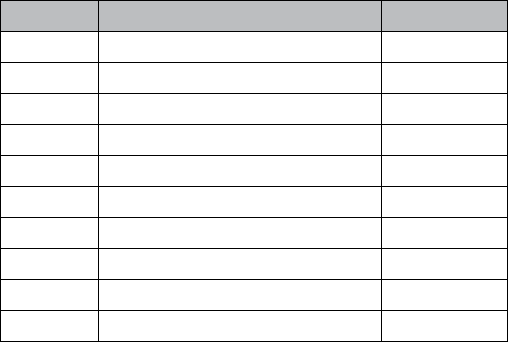
51
See also Search Options on page ____ for Delay, CTCSS/DCS
settings, and locking out/reviewing/unlocking frequencies.
Custom Search Mode
Custom Search mode lets you program and search 10
custom search ranges. You can search any of these ranges
simultaneously and reprogram each custom search range.
During custom search, the scanner searches starting with the
lowest frequency in the search range you select to the highest
frequency in the range.
This feature lets you search through the preset frequency
ranges. (See also Programming Custom Search Ranges, page
___). The preset frequency ranges are:
Bank No. Frequency (MHz) Step (kHz)
1 25.0000-27.9950 5.00
2 28.0000-29.6950 5.00
3 29.7000-49.9950 5.00
4 50.0000-54.0000 5.00
5 108.0000-136.9916 8.33
6 137.0000-143.9950 5.00
7 144.0000-147.9950 5.00
8 225.0000-380.000 12.50
9 406.0000-449.99375 6.25
10 450.0000-469.99375 6.25
To start a Custom Search, press Srch/Svc. When the scanner
nds a transmission, it stops on it. When the transmission ends,
the scanner resumes searching according to the delay setting.
52
While searching, the upper line displays the current search bank
name. The lower line displays the search frequency and the
direction indicator (↑or ↓) with the modulation.
Enabled search banks appear on the lowest line. Disabled search
bank numbers are not displayed. The currently searched bank
number ashes.
• You can turn search banks on/o by using 1-9 or 0. One
search bank must always be enabled. If you turn o all search
banks, the scanner will display Nothing to Srch.
• If you want to change the search direction or if it is a long
transmission and you want to continue searching, turn
SCROLL CONTROL or press Srch/Svc.
Custom Search Receive/Hold Modes
To hold on a frequency, press Hold. To step through the
frequencies, turn SCROLL CONTROL in Hold mode. Press Hold
to resume searching.
While monitoring a transmission, the upper line displays the
current search bank name and the lower line displays the
current frequency with the direction indicator (↑or ↓)
The modulation, Priority mode icon (if priority is enabled), any
CTCSS/DCS received (if enabled), and the Close Call icon (if CC
Pri or CC-DND is enabled) will also appear in the display.
Numbers at the bottom of the display show the enabled service
search banks. The currently searched bank number ashes in
Receive mode.
• To store a frequency, press Pgm/E; see Storing Found Search
Frequencies on page ___.
53
• To temporarily lock out a frequency, press L/O.
• To permanently lock out a frequency, press L/O twice quickly.
See also Search Options on page ___ for Delay, CTC/DCS
settings, and locking out/reviewing/unlocking frequencies.
Quick Search Mode
Quick Search mode allows you to enter a frequency and start
searching up or down from that frequency from any Hold mode
(except Close Call Only/Weather Hold).
To start a Quick Search in Scan or Search mode, press Hold
to hold on any channel or frequency. Enter the new frequency
(include a decimal point so you don’t go to a channel) and press
Hold again to set the frequency.
At Quick Search, press Hold to start searching.
To start a Quick Search at the current frequency during Close
Call Search, turn SCROLL CONTROL in Hold mode and press
Hold to start searching.
When the scanner nds a transmission, it stops on it. When the
transmission ends, the scanner resumes searching according to
the delay setting.
While searching in Quick Search mode, the upper line
displays Quick Search and the lower line displays the
searching frequency and the direction indicator (↑or ↓) with the
modulation.
If you want to change the search direction or if it is a long
transmission and you want to continue searching, turn SCROLL
CONTROL or press Srch/Svc.
54
Quick Search Receive/Hold Modes
To hold on a frequency press Hold. To step through the
frequencies, turn SCROLL CONTROL in Hold mode. Press Hold
to resume.
While monitoring a transmission, the upper line displays Quick
Search and the lower line displays the current frequency and
the direction indicator (↑or ↓).
The modulation, Priority mode icon (if Priority is enabled), any
CTCSS/DCS received (if enabled), and the Close Call icon (if CC
Pri or CC-DND is enabled) will also appear in the display.
• To store a frequency, press Pgm/E. Refer to Storing Found
Search Frequencies on page ____.
• To temporarily lock out a frequency, press L/O.
• To permanently lock out a frequency, press L/O twice
quickly.
• To exit Quick Search, press Scan.
See also Search Options on page ___ for Delay, CTCSS/DCS
settings, and locking out/reviewing/unlocking frequencies.
Search Options
Search Delay
This setting controls how many seconds the scanner waits after
a transmission ends before resuming searching. If you select a
minus delay time, the scanner stops on the transmission for the
setting time and then automatically resumes scanning. (Default
= 2 seconds)
1. Press Func then Pgm/E in Service, Custom, or Quick
Search/Search Hold mode to view the Search menu.
55
2. Scroll to Set Delay and press Pgm/E.
3. Scroll to select the delay time from the following options:
• -10 sec - resumes after 10 seconds.
• -5 sec - resumes after 5 seconds.
• 0 sec - resumes immediately.
• 1 sec - waits 1 second for a reply then resumes.
• 2 sec - waits 2 seconds for a reply then resumes.
• 3 sec - waits 3 seconds for a reply then resumes.
• 4 sec - waits 4 seconds for a reply then resumes.
• 5 sec - waits 5 seconds for a reply then resumes.
4. Press Pgm/E to save and return to previous menu.
CTCSS/DCS Search
This setting controls whether the scanner will search for a
subaudible tone when it stops on a transmission during a
Service Search. (Default = On)
1. Press Func then Pgm/E in any Service, Custom, or Quick
Search/Search Hold mode to view the Search menu.
2. Scroll to CTCSS/DCS Search and press Pgm/E.
3. Scroll to select one of the following settings:
• Search O
• Search On
4. Press Pgm/E to save and return to previous menu.
Programming Custom Search Ranges
You can dene each search range used during a Custom Search.
56
1. Press Func then Pgm/E in Custom Search mode to view
the Search menu.
2. Scroll to Program Limits and press Pgm/E.
3. Scroll to Search Bank 1-10 and press Pgm/E. You will see
the previously programmed lower frequency. At Lower,
press Pgm/E and use the keypad to enter the lower limit
frequency then press Pgm/E.
4. Scroll to Upper and press Pgm/E. You will see the
previously programmed upper frequency. Use the keypad
to enter the upper limit frequency then press Pgm/E.
5. Press . Clr to return to the Select Bank menu. Repeat for
each custom search bank you want to reprogram then
press Srch/Svc to start searching.
Storing Found Search Frequencies
You can store found frequencies into the channel storage banks
in any Search mode, any Close Call mode, or Weather Scan
mode.
• To store a frequency, press Pgm/E.
• To store a frequency in the Close Call Hits bank to a Channel
Storage Bank in Scan mode, press Func then Pgm/E.
Save Frequency displays and the scanner shows the rst
empty channel location. To select another location, turn
SCROLL CONTROL to select another channel then press Pgm/E
to store the frequency or . Clr to exit and return.
The scanner saves the frequency to the channel location and
brings you to the channel menu for the channel so you can
customize the channel options.
57
Scroll to to any channel options desired to edit.
(See Programming Channels, page ___).
Locking Out Search Frequencies
You can lock up to 200 search frequencies: 100 temporary
frequencies and 100 permanent frequencies.
While receiving a frequency in any Search or Search Hold
mode, press L/O once to temporarily lock out the frequency.
Temporary L/O and TL/O briey appears in the display. When
the scanner is turned o, the temporary lockout is cleared.
Press L/O twice quickly to permanently lock out the frequency.
Locked Out and L/O briey appear in the display. When the
scanner is turned o, the lockout is not cleared.
If you lock out a frequency in Search mode, the scanner will
resume searching from the next frequency.
Notes:
• Any frequency locked out in one Search mode will also be
locked out in all Service, Custom, Quick, and Close Call
Search modes.
• You can still manually select locked-out frequencies.
• If you lock out all frequencies in the selected search bank,
the scanner displays All Locked! on the second line.
Unlocking Search Frequencies
1. Press Func then Pgm/E in any Search or Search Hold
mode to view the Search menu.
2. Scroll to Review Lockouts and press Pgm/E.
58
3. Scroll to view the locked out frequencies. L/O will
indicate a permanent lockout and TL/O will indicate a
temporary lockout. Press the L/O button to unlock any
selected frequency.
To unlock all Search/Close Call frequencies, press and hold L/O
in any Search Hold mode until the scanner prompts Clear All
L/O.
To unlock all search/Close Call frequencies, press and hold
L/O until the scanner prompts Clear All L/O? Press Pgm/E to
conrm or .Clr to cancel.
Press . Clr to resume Searching.
CLOSE CALL
Using the Close Call Feature
Unlike searching, which requires the scanner to tune to a
frequency to check for a transmission, Close Call RF capture
directly detects the presence of a strong, nearby signal and
instantly tunes to the source’s frequency.
Close Call RF capture works great for nding frequencies at
venues such as malls and sporting events. You can set the
scanner so Close Call detection works "in the background"
while you are scanning other frequencies, turn o normal
scanning while Close Call is working, or turn o the Close
Call feature and use the scanner normally. You can set the
scanner so it alerts you when the Close Call feature detects a
frequency. You can also set the frequency bands where you
want the scanner to look for transmissions.
The scanner also automatically stores the last 10 hits received
into a temporary bank called "Close Call Hits" in any Close
59
Call mode. The hits go away when you cycle power. You can
also store these trmporary frequencies into channel storage
banks.
Notes:
• Close Call capture works well for locating the source of
strong local transmissions such as mobile and handheld
two-way radios in areas with no other strong transmission
sources. However, if you are in an area with many
transmission sources (such as pager radio transmitters,
multi-use radio towers, trac control devices, etc.), Close Call
RF capture might not nd the transmission you are searching
for, or it might nd a transmission other than the one you are
searching for.
• Close Call works better with some types of transmissions
than others. It might not correctly display frequency
information for transmitters using a highly directive antenna
(such as an amateur radio beam antenna), if there are many
transmitters operating at the same time in the same area, or
if the transmitter is a broadcast television station.
Selecting Close Call Modes
1. In Scan or Search mode press Func then Hold to enter the
Close Call Menu.
2. Scroll to Close Call mode and press Pgm/E.
3. Scroll to select from the following modes:
• Close Call DND - only checks for Close Call hits between
transmissions avoiding breaks in current transmiss
• Close Call Pri (Priority) - checks for Close Call hits every 2
seconds, even during transmissions.
60
• Close Call O - turns o Close Call.
• Close Call Only - performs continuous Close Call checks
until you exit by pressing Scan or Srch/Svc.
• Back - returns to previous menu.
4. Press Pgm/E to select and return to the Close Call menu.
If Close Call DND or Close Call Pri is selected, the Close Call icon
will display in Scan and Search modes.
Close Call Only Mode
In Close Call Only mode the rst line displays Close Call and
scrolls CC Search from the right to the left on the second line
and the Close Call icon will blink in the display.
Enabled search bands appear on the lowest line. Disabled
search bands are not displayed. The currently searched bank
number ashes.
• To turn Close Call bands on or o, use the number keys (1050
on the keypad.
One search band must always be enabled. If you turn o all
search bands, the scanner will display All Band Off!
• To hold on a specic band, press Hold. Turn SCROLL
CONTROL and select the band to monitor.
When the scanner nds a frequency, CCFOUND! appears in
the display. The scanner will also beep or ash the display (if
enabled) in the Close Call Alert option in the Close Call menu.
• Press any key (other than Hold) to view the displayed
frequency.
61
While monitoring a Close Call transmission, the scanner displays
Close Call on rst line and the monitoring frequency on the
second line.
The modulation and any CTCSS/DCS received (if enabled) will
also appear on the display.
Numbers at the bottom of the display show the enabled Close
Call bands. The currently searched band number ashes.
When the transmission ends, the scanner resumes searching
according to the delay setting.
To hold on a frequency, press Hold.
To start a Quick Search at the current frequency, turn the ScrOLL
CONTROL in Hold mode and press Hold to start searching.
To cancel the hit, turn the Scroll Control.
To temporarily lock out a frequency, press any key then L/O.
To permanently lock out a frequency, press any key then L/O
twice quickly.
To store a frequency, press Pgm/E. See Storing Found Search
Frequencies on page ___.
To exit Close Call Only mode, press Scan.
See Also Close Call options on page ___ for Delay, CTCSS/
DCS, Alert Settings, Setting Close Call Bands, and reviewing/
unlocking frequencies.
62
Setting Close Call Options
Set Close Call Bands
This setting allows you to select the bands searched for all
Close Call modes.
1. Press Func then Hold to view the Close Call menu.
2. Scroll to Close Call Bands and press Pgm/E.
3. Scroll to each band you want to enable/disable and press
Pgm/E.
4. Scroll to select C-Call Band On or Off and press Pgm/E.
• 25-54 V Low - VHF Low Band (25 - 54 MHz)
• 108-137 Air - Air Band (108 - 137 MHz)
• 137-174 V High - VHF High Band (137 - 225 MHz)
• 225-320 Mil Air - Military Air Band (225 - 400 MHz)
• 320-512 UHF - UHF Band (400 - 512 MHz)
• Back - returns to previous menu.
5. Press .Clr (or scroll to Back and press Pgm/E to save and
return to the Close Call menu.
Close Call Alert
This setting controls the Alert Beep and Alert Light settings used
during Close Call operation. (Default = On for both)
1. Press Func then Hold to view the Close Call menu.
2. Scroll to Close Call Alert and press Pgm/E. Select from the
following options:
• Alert Beep - Controls whether the scanner sounds an
alert beep when Close Call detects a signal.
63
• Alert Light - Controls whether the scanner ashes the
display backlight when Close Call detects a signal.
• Back - returns to previous menu.
3. Scroll to any option you want to enable/disable and press
Pgm/E.
4. Scroll to On or Off and press Pgm/E
5. Press .Clr (or scroll to Back and press Pgm/E) to save and
return to the Close Call menu.
Close Call Hits Bank
The scanner saves the last 10 Close Call hits into the Close Call
temporary store bank named “Close Call Hits.”
This setting turns the bank on or o during Scan mode. (Default
= O )
1. Press Func then Hold to view the Close Call menu.
2. Scroll to Scan Hits and press Pgm/E.
3. Scroll to Scan Hits On or Off and press Pgm/E to save and
return to the Close Call menu. (Default = O)
You can also store these temporary frequencies into channel
storage banks when you receive them in Scan mode and scroll
to them in Scan Hold mode.
See also Storing Found Search Frequencies on page __.
Close Call Delay
This setting controls how long the scanner stays on the
frequency after a transmission ends before resuming Close Call
operation. If you select a minus delay time, the scanner stops
64
on the transmission for the preset time and then automatically
resumes scanning. (Default = 2 seconds)
1. Press Func then Hold to view the Close Call menu.
2. Scroll to Set Delay and press Pgm/E.
3. Scroll to select the delay time from following options:
• -10 sec - resumes after 10 seconds.
• -5 sec - resumes after 5 seconds.
• 0 sec - resumes immediately.
• 1 sec - waits 1 second for a reply then resumes.
• 2 sec - waits 2 seconds for a reply then resumes.
• 3 sec - waits 3 seconds for a reply then resumes.
• 4 sec - waits 4 seconds for a reply then resumes.
• 5 sec - waits 5 seconds for a reply then resumes.
4. Press Pgm/E to save and return to the Close Call menu.
Close Call CTCSS/DCS Search
This setting controls whether the scanner will search for a
subaudible tone when it stops on a transmission during Close
Call operation. (Default = On)
1. Press Func then Hold to view the Close Call menu.
2. Scroll to CTCSS/DCS Search and press Pgm/E.
3. Scroll to select one of the following options:
• Search O
• Search On
4. Press Pgm/E to save and return to the Close Call menu.

65
WEATHER OPERATION
Your scanner has been primarily designed as a multi-band,
general services scanner. While it incorporates a weather alert
ability as one of its features, we recommend that you not use
the scanner as your sole means for receiving emergency alerts.
Your local electronics retailer can supply a selection of weather
radios that are dedicated to weather service monitoring. Such
radios can be more dependable for this application.
SEARCHING FOR A WEATHER BROADCAST
To monitor a weather channel, press Func then 3WX to view
the Weather menu.
Scroll to Weather Scan and press Pgm/E.
The upper line displays WX Scan and the lower line displays
the scanning frequency with the channel number and the
modulation.
The scanner starts scanning the preprogrammed weather
frequencies, and stops on the rst good signal. Generally, there
will be one channel of the seven that you will receive best. If
this station is weak, turn the Scroll Control to check for other
weather broadcasts in your area.
Notes:
• NOAA broadcasts are continuous broadcasts. You only
lose reception if you move out of a coverage area. If the
signal is lost, the scanner resumes searching for a weather
transmission.
• You cannot lock out weather frequencies.
66
WEATHER ALERT STANDBY
In Weather Alert mode, your scanner functions as a severe
weather warning radio. This is especially useful when your area
is expecting severe weather conditions late at night. When you
set the scanner to Weather Alert mode, it scans the weather
channels, but does not play the channel’s audio.
To turn Weather Alert Standby on or o, press Func then
3WX to view the Weather menu.
Scroll to Weather Standby and press Pgm/E.
The upper line displays WX Alert Standby and the lower
lines display the channel number with the frequency and
modulation.
When the scanner detects the Weather Alert Tone (1050Hz), the
scanner goes into Hold mode, immediately sounds a Weather
Alert siren and displays WX Alert Warning. This siren sounds as
long as the Weather Alert Tone (1050Hz) is broadcasted.
Pressing any key stops the siren, opens the squelch, then
monitors the Weather channel.
To exit Weather Alert Standbymode, press Scan.
WEATHER ALERT PRIORITY
Enabling this setting assigns priority to weather alert scanning
no matter what else the radio might be doing. Checking the
weather channel every 5 seconds for a 1050Hz tone assures you
of the latest occurrence of a NOAA warning. (Default = O)
To turn Weather Alert Priority on or o, press Func then 3WX
to view the Weather menu.

67
Scroll to Alert Priority and press Pgm/E.
Scroll to select WX Priority On or Off and press Pgm/E to save
and return to the Weather menu.
Press Scan or Srch/Svc to exit.
While Weather Alert Priority is active, WX appears in the display.
If no carrier is on any Weather channel, the scanner displays No
WX Reception WX Priority Off and turns Weather Alert Priority
o.
REFERENCES
CTCSS FREQUENCIES
67.0 69.3 71.9 74.4 77.0 79.7
82.5 85.4 88.5 91.5 94.8 97.4
100.0 103.5 107.2 110.9 114.8 118.8
123.0 127.3 131.8 136.5 141.3 146.2
151.4 156.7 159.8 162.2 165.5 167.9
171.3 173.8 177.3 179.9 183.5 186.2
189.9 192.8 196.6 199.5 203.5 206.5
210.7 218.1 225.7 229.1 233.6 241.8
250.7 254.1
68
DSC CODES
023 025 026 031 032 036 043 047
051 053 054 065 071 072 073 074
114 115 116 122 125 131 132 134
143 145 152 155 156 162 165 172
174 205 212 223 225 226 243 244
245 246 251 252 255 261 263 265
266 271 274 306 311 315 325 331
332 343 346 351 356 364 365 371
411 412 413 423 431 432 445 446
452 454 455 462 464 465 466 503
506 516 523 526 532 546 565 606
612 624 627 631 632 654 662 664
703 712 723 731 732 734 743 754

69
WARRANTY
ONE YEAR LIMITED WARRANTY
Important: Evidence of original purchase is required for
warranty service.
WARRANTOR: UNIDEN AMERICA CORPORATION (“Uniden”)
ELEMENTS OF WARRANTY: Uniden warrants, for one year, to
the original retail owner, this Uniden Product to be free from
defects in materials and craftsmanship with only the limitations
or exclusions set out below.
WARRANTY DURATION: This warranty to the original user
shall terminate and be of no further eect 12 months after the
date of original retail sale. The warranty is invalid if the Product
is (A) damaged or not maintained as reasonable or necessary,
(B) modied, altered, or used as part of any conversion kits,
subassemblies, or any congurations not sold by Uniden, (C)
improperly installed, (D) serviced or repaired by someone
other than an authorized Uniden service center for a defect
or malfunction covered by this warranty, (E) used in any
conjunction with equipment or parts or as part of any system
not manufactured by Uniden, or (F) installed or programmed
by anyone other than as detailed by the owner’s manual for this
product.
STATEMENT OF REMEDY: In the event that the product does
not conform to this warranty at any time while this warranty
is in eect, warrantor will either, at its option, repair or replace
the defective unit and return it to you without charge for parts,
service, or any other cost (except shipping and handling)
70
incurred by warrantor or its representatives in connection with
the performance of this warranty. Warrantor, at its option, may
replace the unit with a new or refurbished unit. THE LIMITED
WARRANTY SET FORTH ABOVE IS THE SOLE AND ENTIRE
WARRANTY PERTAINING TO THE PRODUCT AND IS IN LIEU OF
AND EXCLUDES ALL OTHER WARRANTIES OF ANY NATURE
WHATSOEVER, WHETHER EXPRESS, IMPLIED OR ARISING BY
OPERATION OF LAW, INCLUDING, BUT NOT LIMITED TO ANY
IMPLIED WARRANTIES OF MERCHANTABILITY OR FITNESS
FOR A PARTICULAR PURPOSE. THIS WARRANTY DOES NOT
COVER OR PROVIDE FOR THE REIMBURSEMENT OR PAYMENT
OF INCIDENTAL OR CONSEQUENTIAL DAMAGES. Some states
do not allow this exclusion or limitation of incidental or
consequential damages so the above limitation or exclusion
may not apply to you.
LEGAL REMEDIES: This warranty gives you specic legal rights,
and you may also have other rights which vary from state to
state. This warranty is void outside the United States of America
and Canada.
PROCEDURE FOR OBTAINING PERFORMANCE OF
WARRANTY:
If, after following the instructions in the owner’s manual you are
certain that the Product is defective, pack the Product carefully
(preferably in its original packaging). The Product should include
71
all parts and accessories originally packaged with the Product.
Include evidence of original purchase and a note describing the
defect that has caused you to return it. The Product should be
shipped freight prepaid, by traceable means, to warrantor at:
Uniden America Corporation
Parts and Service Division
4700 Amon Carter Blvd.
Fort Worth, TX 76155
(800) 297-1023, 8 a.m. to 5 p.m. CST, Monday through Friday
72